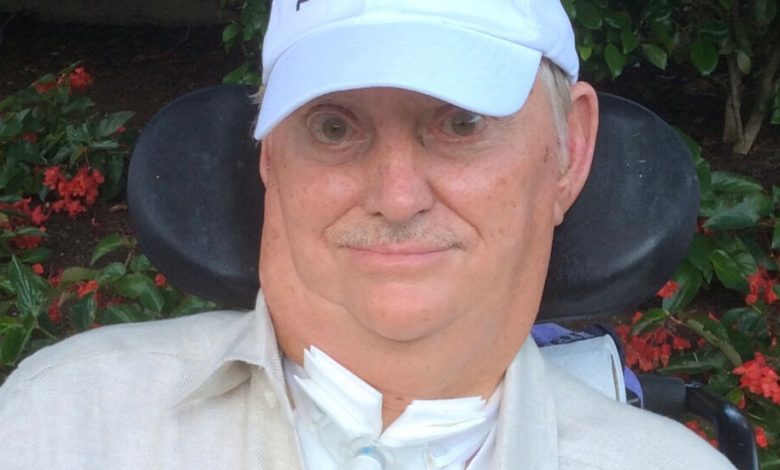Robert Paulson, Long-Term A.L.S. Survivor, Is Dead at 86

Long after being diagnosed with amyotrophic lateral sclerosis, better known as Lou Gehrig’s disease, Robert Paulson published his autobiography. He could not move by then, much less type, so he created the book in four months from his wheelchair by employing a text-generating device that uses the eye as a cursor to select letters.
“A million clicks of his eye,” his wife, Maureen (Dowling) Paulson, said in a phone interview. “He got pretty proficient at it.”
In his book, “Not in Kansas Anymore: A Memoir of the Farm, New York City and Life with A.L.S.” (2009), Mr. Paulson wrote, “The diagnosis of this disease need not be a death sentence.”
Later in the book, he observed: “Life is everything. And what is it but the ability to feel, think and communicate? Thanks to today’s technologies, A.L.S. can’t take any of these from you.”
Mr. Paulson, who spoke through a speech synthesizer, built a public profile as a face of A.L.S. with his book, with interviews he gave and with appearances he made, with his wife, before audiences including students at Sacred Heart University, in Fairfield, Conn., and prisoners at Rikers Island. His messages, Mrs. Paulson said, centered on resilience and coping when “terrible things come your way.”
“He’d say, ‘It rains on all of us,’” she added. “It was a good message for kids to hear.”
Mr. Paulson spoke in 2018 to a disabilities studies course taught by Allan B. Goldstein at the New York University Tandon School of Engineering.
“What he brought was the knowledge that disability was not a tragedy, that it’s just a different way of living,” Mr. Goldstein said by phone. “And they got that viscerally.”
Kailey Blount, who attended a disability and literature class at Sacred Heart at which Mr. Paulson appeared, said that he helped her cope with the effects of ulcerative colitis. “In a time where I was frozen by disability,” she said by email, “Mr. Paulson lit a path forward. His brilliant mind, kind heart and dignified soul guided me towards a brighter future.”
Mr. Paulson died on Aug. 8 at his home in Manhattan, his wife said, 30 years after he experienced the first symptoms of the disease to which he finally succumbed. He was 86.
With the aid of crucial interventions at various points after his diagnosis — including a tracheotomy, a ventilator and a feeding tube — Mr. Paulson lived an unusually long time with the disease. The average survival time is three years, according to the A.L.S. Association, and only 5 percent of people with the disease live 20 years or longer. The physicist Stephen Hawking was an outlier: He was diagnosed with A.L.S. at age 21, and he survived with it until his death in 2018, 55 years later.
Robert Edward Paulson was born on June 27, 1937, in his mother’s bedroom on his family’s wheat, soybean and alfalfa farm in Lindsborg, Kan., a small city founded by Swedish settlers. His father, Nils, died before Bob turned 2. His mother, Ellen (Karlsson) Paulson, who had immigrated from Sweden, took over the running of the farm after her husband’s death.
“It was up to my three older brothers and me to scratch out a living as we grew up,” Mr. Paulson told the website of Bridging Voice, an organization that helps people with neurodegenerative disorders communicate through training and equipment, in 2021. “My childhood was all grit and dogged determination.”
Bob hated farming, so he followed the example of his brother Arnold, a nuclear engineer. He studied nuclear engineering at Kansas State University and graduated with a bachelor’s degree in 1959. The coach of his debate team there suggested that, given his ability to deliver an argument, he would make a good lawyer.
He attended Georgetown Law School at night while working on classified matters during the day at the United States Atomic Energy Commission (which was later split into two agencies, one of them the Nuclear Regulatory Commission, in 1974). He graduated in 1963.
With his background in science, he specialized in patent law.
“My life as an attorney, before A.LS., entailed standing up and speaking in federal court,” he told Bridging Voice. “I used my voice in every part of the law.” He also sang in opera workshops, glee clubs and church choirs.
But his ability to stand, speak and sing began to erode in the 1990s, as his fingers, arms, legs and stomach muscles weakened. He went from using a cane to a walker and, in 1998, to a wheelchair. But he continued to work as a partner at Morgan & Finnegan, an intellectual property law firm in Manhattan, for five more years. He stopped when he could no longer use his limbs and keep up with the billing.
In late 2003, when pneumonia led to the failure of his lungs, he required a tracheotomy and breathing and feeding tubes. “I can do this, I’m already in a wheelchair,” he recalled of his reaction to the latest change in the state of his health when he was interviewed a few years later by the Muscular Dystrophy Association’s A.L.S. division.
He adjusted over the next 20 years, with help from his wife; his sons, Joshua, Luke and James; and others. He started his own patent law firm, with a client list that included the United States Chamber of Commerce; wrote his autobiography; and compiled a synopsis of more than 200 decisions in trademark and copyright law from 2013 to 2020.
In addition to his wife, Mr. Paulson is survived by his sons, four grandchildren and his brother Arnold.
Mrs. Paulson said that despite his condition, her husband retained a largely positive disposition.
“He was willing to face the day,” she said. “He’d wake up, maybe you’d see a few tears in his eyes, but he’d charge ahead. I’d get him in the wheelchair, and off we’d go.”




